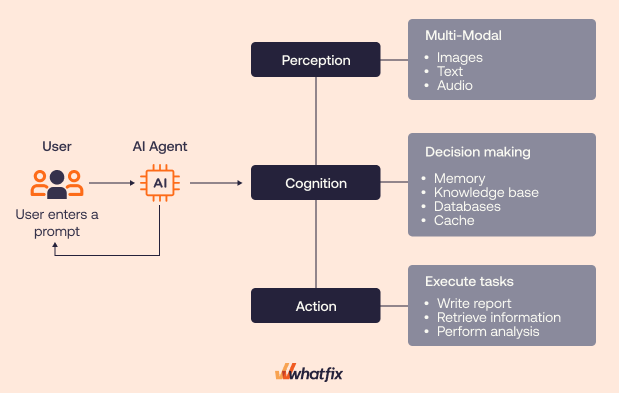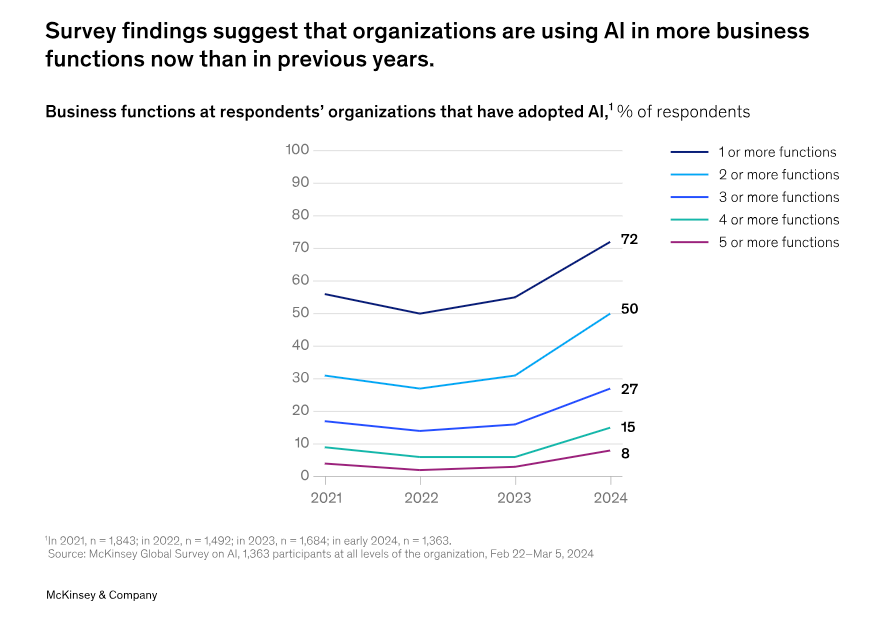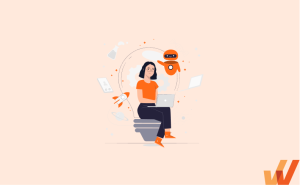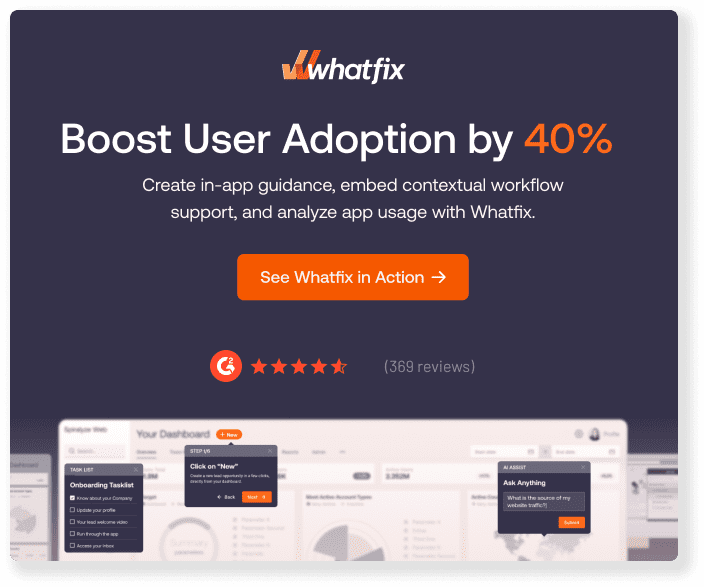AI agents are quickly capturing the spotlight in consumer-facing roles and back-end operations. They’re touted as virtual teammates capable of independently managing tasks, personalizing customer interactions, and drastically cutting operational costs.
Gartner predicts that by 2026, enterprises adopting AI engineering practices will increase operational efficiency by at least 25%, underscoring AI’s potential as a transformative technology.
But beneath the impressive headlines and captivating use cases lies a deeper question: Are organizations becoming too reliant on AI agents?
Companies increasingly entrust AI agents with responsibilities like handling customer inquiries, streamlining marketing operations, assisting HR functions, and supporting complex decision-making. But with rapid adoption comes major potential risks—errors that compound silently, unpredictable behaviors when faced with novel scenarios, spiraling costs, and privacy concerns that amplify as AI becomes embedded across multiple business layers.
Despite AI’s extraordinary capabilities, it still lacks essential human qualities like empathy, intuition, and nuanced judgment, which are critical in many real-world situations. Customers and employees alike report mixed feelings about interacting primarily with automated systems. A PwC study found that 59% of consumers feel companies have lost touch with the human element of customer experience due to excessive automation.
Organizations must strike a balance—implementing AI agents to augment human capabilities, not replace them.
In this article, we’ll explore AI agents in-depth, from their benefits and technical workings to their limitations and alternatives. You’ll learn why overreliance on AI can be a strategic misstep and how solutions like Whatfix can effectively bridge the gap, transforming support and operational teams without sacrificing human insight and empathy.
What Are AI Agents?
An AI agent is a software-based system designed to independently analyze its environment, process available information, and execute the most appropriate actions to achieve defined objectives. While human operators outline and set goals, an AI agent autonomously navigates tasks, making real-time decisions based on data-driven insights.
Benefits of AI agents include:
- Task automation: AI agents seamlessly handle repetitive, mundane, or time-consuming tasks, allowing teams to allocate their energy toward more strategic or creative responsibilities. Companies across industries are integrating AI agents to assist with data analysis, write code, and more, reflecting a significant shift toward enhancing operational efficiency.
- Better performance and continuous learning: Unlike traditional software, AI agents learn from each interaction, continuously improving their knowledge base and skill set. Each successful task informs future actions, making their performance more accurate and reliable over time. This adaptive capability ensures continuous optimization and enhances effectiveness as they handle evolving tasks and scenarios.
- Personalized, high-quality actions and responses: AI agents draw from extensive data points, enabling them to understand context, user intent, and sometimes even user sentiment. This allows them to deliver tailored responses and actions that resonate with individual users.
- Reduced costs and scalability: AI agents can significantly decrease operational expenses associated with routine tasks and administrative duties. With an AI agent, businesses can scale their operations efficiently and serve more customers without proportionally increasing costs or headcount. This scalability makes AI agents appealing to organizations experiencing fast growth or seasonal demand fluctuations.
How Do AI Agents Work?
AI agents don’t just magically understand tasks—they follow a structured process to gather information, analyze it, and act based on predefined goals. Their intelligence is built through careful training, ongoing guidance, and continuous learning from real-world interactions.
1. Humans set goals and train AI
The journey of an AI agent starts with people clearly defining objectives and training guidelines. Humans feed AI agents relevant datasets, specify performance expectations, and set guardrails to ensure safe and responsible decision-making. Essentially, human trainers equip AI agents with foundational knowledge, setting benchmarks to gauge their effectiveness and fine-tune their responses.
For example, in customer support scenarios, humans train agents on previous interactions, helping them to understand the context and expected outcomes when handling similar requests.
2. AI performs best actions to achieve goals based on available information
When an AI agent receives a prompt or request, it utilizes three different components to execute the task:
- Perception: AI agents collect data from various sources to better understand the situation or request. This data can include customer interactions, previous transaction records, historical communications, and even social media activity. By gathering this unique insight, AI agents get a comprehensive view of the context surrounding a request or problem.
- Cognition: After gathering and interpreting data, AI agents use machine learning (ML) models, often powered by large language models (LLMs), to analyze this information and make intelligent, data-driven decisions. The AI synthesizes inputs, evaluates possible outcomes, and determines the most appropriate action based on previous experiences and established patterns.
- Action: Finally, AI agents execute the action they deem most fitting. This could mean responding directly to customer questions, initiating transactions, routing requests to the correct human expert, or triggering automated workflows.

3. AI continuously learning, improving, and adapting
AI agents don’t stop improving once they go live. Every interaction, decision, and outcome provides valuable feedback that helps improve methods.
Successful actions reinforce decision-making patterns, while failures or suboptimal outcomes highlight areas for improvement. As a result, AI agents continuously improve its performance, ensuring responses become more accurate, effective, and contextually relevant over time.
This adaptive learning capability makes AI agents uniquely powerful and capable of evolving alongside shifting business needs and user expectations.
Agentic vs. Non-Agentic AI
Understanding the differences between these two AI categories helps organizations set realistic expectations about what AI can—and can’t—achieve. Agentic AI promises adaptability and autonomy but increases complexity and considerations around trust, control, and oversight. Non-agentic AI is simpler, safer, and easier to control, but lacks the sophistication needed to handle varied or unpredictable situations.
Agentic AI systems
Agentic AI systems can operate autonomously, proactively interacting with their environments, making decisions, and executing tasks independently. They’re goal-oriented and can navigate complex, dynamic situations without constant human supervision.
Think of an AI-powered chatbot that doesn’t just answer your question, but proactively suggests helpful resources or follows up later to confirm your problem is fully resolved. These AI agents continually adapt and refine their approaches, learning from new data and experiences every time.
Non-agentic AI systems
Non-agentic AI systems depend heavily on direct human input or supervision and typically perform narrowly defined tasks based solely on predetermined rules or scripts. Non-agentic AI doesn’t independently pursue goals, make nuanced decisions, or adjust its actions dynamically—it just follows instructions.
For example, a traditional rules-based chatbot can provide predetermined responses to frequently asked questions but struggles to handle unique requests or complicated scenarios outside its scripted knowledge base.
Understanding the differences between these two categories helps organizations set realistic expectations about what AI can—and can’t—achieve. Agentic AI promises adaptability and autonomy but increases complexity and considerations around trust, control, and oversight. Non-agentic AI is simpler, safer, and easier to control, but lacks the sophistication needed to handle varied or unpredictable situations.
Ultimately, choosing between agentic and non-agentic AI depends on your specific goals, use cases, and AI readiness to manage the opportunities and challenges each approach presents.
| Agentic AI | Non-Agentic AI | |
| Definition | AI systems that operate autonomously with a level of perceived “agency,” making decisions and taking actions without direct human intervention | AI systems are designed to follow pre-defined rules or patterns, typically reliant on human prompts or scripts |
| Decision-Making | Independent, goal-oriented decision-making | Pre-programmed, reactive decision-making |
| Learning Capability | Continuously learns, adapts, and improves from interactions and experiences | Limited or no learning; relies on static models or predetermined instructions |
| Examples | Autonomous agents like AutoGPT, ChatGPT with agent-like plugins | Traditional chatbots, rule-based systems, recommendation engines |
| Use Cases | Customer support automation, personal assistants, autonomous vehicles | FAQs systems, content recommendation, workflow automation |
| Risks | Compounding errors, ethical concerns, data privacy issues | Limited functionality, lack of adaptability |
| Human Oversight | Can operate with minimal human oversight but requires monitoring and guardrails | Relies heavily on human inputs and oversight |
ReAct vs. ReWOO
Both ReAct and ReWOO are AI frameworks, but have distinct strengths: ReAct is beneficial for scenarios that require adaptability and real-time adjustments, where flexibility and quick corrections are key. ReWOO excels in structured situations, like tasks requiring thoughtful planning, clearly defined sequences, and exact outcomes.
Choosing between ReAct and ReWOO depends on your AI agent’s intended use case, the complexity of tasks at hand, and the level of predictability within the environment.
ReAct
ReAct (Reasoning and Acting) is designed to help AI agents reason their way through problems step-by-step, enabling more effective decision-making.
With this approach, AI agents alternate between reasoning about what action to take, and executing those actions based on their conclusions. An AI agent continuously evaluates outcomes, allowing it to adapt quickly and correct its course as necessary. This structure helps AI agents tackle more dynamic tasks, as they systematically evaluate scenarios rather than acting purely based on pre-defined patterns or rules.
ReWOO
ReWOO (Reasoning Without Observation Outputs) provides AI agents with an enhanced reasoning method, enabling them to outline, strategize, and plan workflows upfront.
Rather than continuously alternating between thinking and acting, ReWOO agents develop a structured approach to tasks by breaking them down into smaller, manageable subtasks, which are then executed sequentially. AI agents reduce mistakes and unnecessary iterations by pre-planning the entire action flow.
Both ReAct and ReWOO are AI frameworks, but have distinct strengths: ReAct is beneficial for scenarios that require adaptability and real-time adjustments, where flexibility and quick corrections are key. ReWOO excels in structured situations, like tasks requiring thoughtful planning, clearly defined sequences, and exact outcomes. Choosing between ReAct and ReWOO depends on your AI agent’s intended use case, the complexity of tasks at hand, and the level of predictability within the environment.
| ReAct | ReWOO | |
| Definition | Framework where AI models reason and take actions based on their understanding of the environment | Framework focused solely on reasoning, generating insights, or recommendations without performing actions |
| Goal | Achieving tasks through a combination of reasoning and active decision-making | Providing information, insights, or suggestions without direct action |
| Typical Use Case | Virtual assistants, autonomous agents, task automation systems | Research tools, knowledge generation, predictive analytics |
| Learning Approach | Continuously improves from actions and feedback loops | Improves reasoning capabilities based on inputs and training data, but not action-oriented |
| Risk Level | Higher potential for compounding errors due to action-oriented nature | Lower risk; limited to incorrect reasoning or output generation |
| Human Intervention | Can operate autonomously but needs guardrails | Always requires human interpretation of results |
| Example Tools | AutoGPT, BabyAGI | ChatGPT, Research Assistants, Predictive Models |
Types of AI Agents
To better understand the capabilities and limitations of AI agents, it helps to categorize them based on how they perceive their environment and make decisions.
Here are six primary types of AI agents and how they function:
1. Simple reflex agents
Simple reflex agents are the most basic type of AI agent. They operate solely on current perceptions, reacting to environmental cues without relying on memory, context, or previous experiences. These AI agents follow a straightforward, condition-action rule set, making them fast and efficient—but limited in handling complexity.
2. Model-based reflex agents
Model-based reflex agents enhance simple reflex agents by incorporating an internal understanding of the world. These agents maintain a basic model or representation of their environment, allowing them to make more informed decisions based on context and recent events.
3. Goal-based agents
Goal-based agents add an extra layer of sophistication by considering future outcomes when deciding on an action. Instead of reacting to immediate inputs, they evaluate their options against predetermined goals, choosing the path most likely to lead to the desired outcome.
4. Utility-based agents
Utility-based agents evaluate actions based on a utility function, measuring the value or satisfaction of various outcomes. Unlike goal-based agents, they don’t just aim for a predefined outcome—they actively weigh trade-offs to maximize overall satisfaction or benefit, even in uncertain situations.
5. Learning agents
Learning agents improve their performance through experience. They continuously refine their decision-making skills by analyzing outcomes and adjusting their internal models. These agents evolve, adapting to changing scenarios and increasingly complex environments.
6. Hierarchical agents
Hierarchical agents break complex tasks into manageable subtasks, organizing their actions within a structured hierarchy. This approach allows them to systematically tackle intricate, multifaceted problems, improving efficiency and effectiveness by managing simpler subgoals before addressing overarching objectives.
AI Agent Use Cases
AI agents are transforming operations across multiple business functions and industries by automating tasks, enhancing decision-making, and personalizing interactions.
AI Use Cases By Business Function & Job Role:
Here are a few AI agent use cases by business function:
- Service teams: AI agents can handle routine customer support tasks, instantly resolving common help desk queries and routing complex issues to human agents. This reduces wait times, boosts customer satisfaction, and allows human teams to focus on higher-value interactions.
- Sales: Sales teams use AI agents to qualify leads, follow up on inquiries automatically, and provide personalized product recommendations. AI agents also analyze buyer behaviors and patterns to identify cross-selling or upselling opportunities.
- Marketing: AI agents support marketing teams by automating personalized campaigns, analyzing customer sentiment, and providing real-time insights into campaign performance. This empowers marketers to quickly adjust strategies and deliver targeted, relevant messaging to audiences.
- HR: HR departments use AI agents to streamline candidate screening, manage interview scheduling, and provide personalized onboarding experiences for new hires. This accelerates recruitment timelines and ensures consistency in employee onboarding and training processes.
- L&D teams: AI agents enable L&D teams by providing personalized and adaptive learning experiences, curating training content, coaching learners with virtual assistants, and analyzing training analytics for predictive insights.
AI Use Cases By Sector
AI agents also provide tailored solutions to solve contextual, industry-centric challenges. Here are a few AI agent use cases by industry:
- E-commerce and retail: Retailers use AI agents to offer personalized product recommendations, automate customer interactions, and manage inventory forecasting. AI agents analyze buying patterns, seasonal trends, and customer preferences to optimize inventory and increase sales conversions. Old Navy implemented RADAR, an advanced system combining RFID, AI, and computer vision to track inventory in real-time across 1,200 stores. This technology assists employees in quickly locating products and managing restocks efficiently, enhancing the in-store shopping experience.
- Banking: Banks leverage AI agents to handle routine customer inquiries, detect fraudulent transactions in real-time, and automate financial advice. This improves banking customer experience and reduces operational risks through proactive monitoring and fraud detection. NatWest’s collaboration with OpenAI led to enhancements in their customer chatbot, resulting in a 150% improvement in customer satisfaction and reduced reliance on human advisors.
- Healthcare: Healthcare providers use AI agents for patient monitoring, automated appointment scheduling, and personalized patient communication. AI agents can identify trends in patient health data, enabling proactive interventions and improved patient outcomes. Akido Labs developed ScopeAI to provide medical care to ride-share drivers in New York City, which suggests diagnoses and treatments based on patient symptoms and histories, with human physicians making final decisions.
- Insurance: Insurance companies leverage AI agents to streamline claims processing, automate policy recommendations, and proactively detect fraud. These AI agents reduce administrative burdens, enhance customer experience, and strengthen risk management strategies. Lemonade, a prominent insurtech company, employs an AI system named “AI Jim” to handle claims processing. AI Jim can process and pay claims in as little as three seconds by analyzing the claim details, cross-referencing them with the policy, and running anti-fraud algorithms.
- Manufacturing: Manufacturers use AI agents for predictive maintenance, inventory optimization, and quality control. AI agents continuously monitor machinery performance and proactively flag maintenance needs before breakdowns occur, minimizing downtime and production losses. Siemens utilizes MindSphere, an AI agent that analyzes data from IoT sensors to predict maintenance needs and optimize logistics. This system exemplifies the use of AI to improve operational efficiency and decision-making in manufacturing.
- Pharma: Pharmaceutical companies leverage AI agents to manage clinical trial data, automate regulatory documentation, and identify drug interaction patterns. AI agents significantly accelerate research processes and improve compliance with regulatory standards. Insitro, founded by Daphne Koller, uses AI to pioneer new treatments for diseases like ALS, cancer, and tuberous sclerosis. The company employs machine learning to analyze genetic samples and uncover causal mechanisms that may have been overlooked by human researchers.
Why to Avoid Overreliance on AI Agents
AI agents offer impressive capabilities, but relying too heavily on them can lead to major pitfalls. Understanding these risks empowers organizations to balance technological advantages with essential human judgment.
1. Smaller models are NOT enough to complete real-world tasks
Smaller AI models might appear efficient, cost-effective, and appealing initially, but their limitations quickly surface in complex scenarios.
These models lack the depth to handle nuanced issues, and when presented with sophisticated tasks—like detailed customer interactions or intricate financial analyses—they often deliver incomplete or inaccurate results, leaving teams scrambling to correct costly errors.
As noted by The Star, AI firms are increasingly focusing on leaner models to save on energy and cost, but these may not suffice for intricate tasks.
2. Compounding errors
AI agents typically break down complex tasks into smaller, manageable subtasks. While this simplifies processes, it also creates a cascading effect of errors.
Imagine an AI agent extracting financial data for a company, with each subtask achieving 90% accuracy. Although this seems reliable, the errors multiply: four subtasks at 90% accuracy reduce the overall accuracy to just 66%. Even upgrading to advanced, costly models—capable of 99% accuracy per subtask—still leaves room for compounded errors, resulting in expensive but imperfect outcomes.
In 2024, New York City’s AI-powered chatbot provided advice that contradicted local regulations and, in some cases, suggested illegal practices, highlighting the risks of AI systems propagating errors without human oversight.
3. Unknown reactions when introduced to new or nuanced concepts
AI agents operate best when handling familiar tasks they’ve been trained on. However, AI agents become unpredictable when faced with unfamiliar concepts, unexpected nuances, or scenarios that fall outside their training datasets. Instead of acknowledging uncertainty, they often proceed confidently but inaccurately, potentially leading to misunderstandings, mistakes, or unintended consequences.
4. Rapid cost explosion
AI agents, especially advanced ones, are resource-intensive. As organizations expand their reliance on these systems, costs related to computing power, infrastructure, and maintenance can escalate dramatically.
More accurate and capable models require significantly higher computational resources—meaning companies may find their budgets quickly overwhelmed by the infrastructure and operational expenses required to sustain sophisticated AI agent deployments.
5. Data privacy concerns
AI agents depend heavily on datasets to learn, adapt, and respond. Often, these datasets contain sensitive customer or employee information. Without careful management, robust privacy controls, and strict compliance protocols, AI agents can inadvertently expose sensitive data, increasing the risk of data breaches and regulatory violations, and ultimately damaging customer trust.
A Deloitte survey highlighted growing consumer anxiety, with 68% expressing increased concerns over data privacy and security in the age of generative AI.
6. Ethical issues
Overreliance on AI agents raises serious ethical concerns, including the risk of biased outcomes, unfair decisions, and potential job displacement. AI-driven decisions may unintentionally reinforce existing biases within datasets, leading to discriminatory or unfair results.
Excessive automation driven by AI agents raises questions about accountability, transparency, and the broader societal impacts of replacing human roles entirely with artificial intelligence. Deloitte’s report on the state of generative AI in the enterprise indicates that many leaders are concerned about AI governance and the potential for economic inequality arising from digital adoption.
7. Technical implementation challenges
Successfully implementing AI agents requires considerable technical expertise, proper infrastructure, and ongoing support. Many organizations underestimate the complexity involved—integrating these systems with legacy technologies, training models accurately, and ensuring seamless workflows pose significant challenges. Poorly executed implementations can result in operational disruptions, costly downtime, and reduced productivity.
Whatfix for AI Adoption provides a comprehensive, user-friendly solution to make AI technology implementation more efficient, effective, and scalable with:
- In-app training and onboarding: Contextual training modules guide users in interacting with AI agents within their software
- AI agent adoption support: Real-time walkthroughs teach HR teams, sales agents, and customer support teams how to use AI tools effectively
- Integrated documentation and self-service resources: Step-by-step guides, tooltips, and pop-ups are embedded within software for seamless AI adoption
- Continuous learning and performance monitoring: Analytics identify user struggles, providing targeted guidance and enhancing AI adoption
- Change management made easy: Customizable in-app guidance to communicate AI-related process changes clearly and effectively
8. Lack of “human” touch and emotional intelligence
One critical limitation of AI agents is their inability to fully replicate human emotional intelligence, empathy, and intuition.
Even the most advanced AI agents struggle to genuinely understand and respond effectively to human emotions, subtleties, and complex interpersonal dynamics. Customers and employees still deeply value human interactions, especially during sensitive or emotionally charged situations, making purely AI-driven interactions feel mechanical, impersonal, or inadequate.
Research from Harvard Business School shows that people highly value human empathy and are willing to wait longer for a personal response over an instant AI-generated one, emphasizing the importance of human interaction in customer service.
9. Negative perception of AI agents
Despite AI’s advancements, many customers, employees, and stakeholders still harbor skepticism or outright mistrust toward AI-driven interactions. This negative perception can stem from concerns about privacy, reliability, job displacement, or even ethical considerations around automation. Excessive reliance on AI agents without transparency or human oversight can amplify this feeling of skepticism, harming an organization’s reputation and trustworthiness in the long run.
Best Practices for Implementing AI Agents
Regardless of the concerns and risks, organizations must implement AI agents or fall behind their competitors that do. With that said, here are a few best practices and tips to help you build a foundation for your AI agent implementation strategy:
1. Define clear goals and objectives for implementing AI agents
Start by clearly outlining the goals and outcomes you want your AI agents to achieve. Ambiguous goals lead to unclear results—be explicit about the tasks your AI agents will perform, the metrics you’ll use to measure success, and how these agents will align with broader business objectives.
2. Collect, prepare, and integrate data sets for AI training
As highlighted by Forbes, prioritizing data quality and security is essential for AI success.
Gather comprehensive, clean datasets representing real-world scenarios your AI agents will encounter. Ensure data accuracy, consistency, and coverage to minimize biases and improve decision-making.
With Whatfix, you can create interactive, in-app guidance to help users collect and prepare data for AI training. Whatfix’s real-time training modules also ensure teams understand how to curate and manage data effectively, enhancing AI accuracy.
3. Refine and fine-tune your LLM before launching
Before going live, take time to fine-tune your LLMs. Adjust models based on rigorous testing and feedback loops, correcting biases, enhancing accuracy, and aligning outputs with human expectations. Regularly test your LLM across multiple scenarios to identify gaps or unintended behaviors, refining its responses until it consistently meets your defined goals.
4. Roll out slowly and document results
Avoid rushing your AI agent deployment across the entire organization all at once. Instead, implement your AI agents in increments, piloting first in smaller, manageable areas or specific use cases. Document detailed results and user feedback to continuously measure progress and identify improvements. This cautious approach helps reduce risk and ensures smoother adoption as you scale.
5. Use activity logs
Activity logs are crucial for monitoring your AI agents’ ongoing performance and decisions. By tracking detailed interactions, decisions made, and outcomes achieved, you can more quickly identify patterns of success and potential areas of concern. Activity logs also provide transparency, ensuring accountability and traceability of actions- especially if issues arise.
6. Implement interruptibility
Always design AI agents with mechanisms that allow humans to pause, interrupt, or override their actions if needed. Interruptibility ensures safety, ethical compliance, and flexibility, particularly in high-stakes or sensitive tasks.
7. Assign unique agent identifiers
Assigning unique identifiers to your AI agents enables better accountability, transparency, and traceability. Doing so simplifies monitoring, troubleshooting, and auditing by clearly identifying which agent performed which task or action. With explicit identifiers, your team can pinpoint issues quickly and manage multiple AI agents effectively across various workflows and business units.
Whatfix’s real-time monitoring tools allow organizations to track AI agent interactions and performance across various use cases, ensuring effective auditing and accountability.
8. Always have human oversight and set guardrails
Even the most advanced AI agents require human oversight. Establish clear guardrails and boundaries to guide agent behavior and prevent unintended consequences. Regular human monitoring, especially during early deployment, ensures decisions made by agents align with ethical guidelines, organizational standards, and regulatory requirements. Maintaining strong human oversight builds trust in your AI systems and enhances their reliability.
9. Use AI to complement humans, not replace them
Position AI agents as powerful tools that augment and complement human capabilities rather than outright replacements. Humans excel in judgment, empathy, creativity, and nuanced decision-making—areas AI still struggles with. Communicate internally that the role of AI is to handle repetitive or data-heavy tasks, freeing teams to focus on strategic, complex, or emotionally intelligent tasks that benefit from genuine human insight.
Whatfix ensures organizations can successfully integrate AI agents without sacrificing human expertise or empathy. Instead of positioning AI as a replacement for human workers, Whatfix helps businesses enhance human-AI collaboration by providing:
- Interactive training modules: Clear, engaging in-app training that guides employees on effectively collaborating with AI agents. For example, Whatfix can help call center agents learn how to leverage AI-driven insights to provide faster, more accurate, and personalized customer interactions
- Integrated feedback loops: Whatfix’s analytics allow companies to gather employee feedback on AI agent interactions, enabling continuous optimization and improved human-AI collaboration over time
- Enhanced knowledge sharing: With Whatfix’s digital adoption tools, employees can easily access user documentation, troubleshooting guides, and best practices for working with AI systems, ensuring they feel empowered rather than threatened by AI integration
10. Monitor AI trends as the technology advances
AI is evolving every day. Stay informed about the latest developments, technologies, methodologies, and regulations to ensure your AI strategy remains relevant, compliant, and competitive. Regularly review your AI deployment against industry benchmarks and best practices, proactively adapting your approach to keep pace with innovations and maximize AI’s potential within your organization.
AI Technologies Click Better With Whatfix
Despite the hype, AI agents aren’t a silver bullet. While AI certainly has its strengths—automating tasks, delivering faster responses, and providing impressive scalability—it shouldn’t be treated as a one-size-fits-all solution. The reality is that AI agents can’t replicate the human touch, empathy, or nuanced judgment essential for building real, lasting connections with customers.
Instead of seeing AI as a replacement, it’s far more effective to view it as a powerful complement to well-trained teams. As a digital adoption platform, Whatfix empowers organizations to transform support experiences without sacrificing the essence of great service—human connection.
With Whatfix, businesses can enhance support agent performance through in-app training and onboarding, ensuring that agents are always equipped with the right knowledge and skills. Whatfix also offers interactive guidance that allows customers to self-serve seamlessly, reducing friction and improving satisfaction. As AI agents become increasingly prevalent, Whatfix ensures end-users— whether customers or employees—can quickly learn how to interact with AI tools effectively.

Implementing AI agents successfully requires the right tools and frameworks. Whatfix simplifies the deployment process with:
- Interactive guidance & self-service: Empower customers and employees with step-by-step tutorials and self-help resources to navigate processes independently.
- AI adoption support: Provide employees and customers with on-demand learning tools that make AI agents easier to use and more effective over time.
- Maximized ROI on software investments: Enhance productivity and software utilization by ensuring users can easily access the tools and resources they need.
- Consistent, high-quality user experiences: Maintain exceptional service quality by enhancing—not replacing—human capabilities with scalable digital adoption solutions.
Ready to enhance your digital experiences without sacrificing the human touch? Start your AI adoption journey with Whatfix today.













